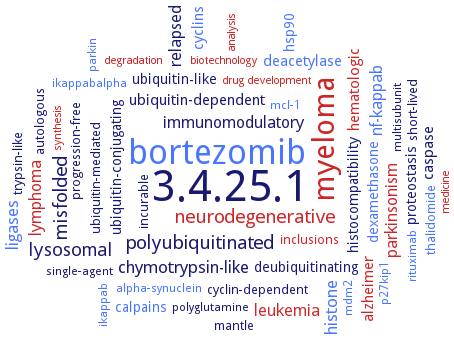3.4.25.1: proteasome endopeptidase complex
This is an abbreviated version!
For detailed information about proteasome endopeptidase complex, go to the full flat file.

Word Map on EC 3.4.25.1 
-
3.4.25.1
-
bortezomib
-
myeloma
-
polyubiquitinated
-
neurodegenerative
-
misfolded
-
lysosomal
-
histone
-
chymotrypsin-like
-
ligases
-
leukemia
-
relapsed
-
nf-kappab
-
immunomodulatory
-
parkinsonism
-
lymphoma
-
deacetylase
-
ubiquitin-dependent
-
alzheimer
-
cyclins
-
hematologic
-
caspase
-
histocompatibility
-
proteostasis
-
ubiquitin-like
-
dexamethasone
-
hsp90
-
deubiquitinating
-
ubiquitin-conjugating
-
calpains
-
autologous
-
inclusions
-
incurable
-
cyclin-dependent
-
short-lived
-
mantle
-
trypsin-like
-
progression-free
-
thalidomide
-
ubiquitin-mediated
-
polyglutamine
-
ikappab
-
mcl-1
-
multisubunit
-
mdm2
-
ikappabalpha
-
parkin
-
rituximab
-
alpha-synuclein
-
single-agent
-
p27kip1
-
synthesis
-
medicine
-
degradation
-
analysis
-
drug development
-
biotechnology
- 3.4.25.1
- bortezomib
- myeloma
-
polyubiquitinated
- neurodegenerative
-
misfolded
- lysosomal
- histone
-
chymotrypsin-like
- ligases
- leukemia
-
relapsed
- nf-kappab
-
immunomodulatory
- parkinsonism
- lymphoma
- deacetylase
-
ubiquitin-dependent
- alzheimer
- cyclins
- hematologic
-
caspase
-
histocompatibility
-
proteostasis
-
ubiquitin-like
- dexamethasone
- hsp90
-
deubiquitinating
-
ubiquitin-conjugating
- calpains
-
autologous
- inclusions
-
incurable
-
cyclin-dependent
-
short-lived
-
mantle
-
trypsin-like
-
progression-free
- thalidomide
-
ubiquitin-mediated
-
polyglutamine
- ikappab
- mcl-1
-
multisubunit
- mdm2
- ikappabalpha
- parkin
- rituximab
- alpha-synuclein
-
single-agent
- p27kip1
- synthesis
- medicine
- degradation
- analysis
- drug development
- biotechnology
Reaction
cleavage of peptide bonds with very broad specificity =
Synonyms
20 S proteasome, 206 proteasome, 20S CP, 20S protease core, 20S proteasome, 26 S proteasome, 26S protease, 26S proteasome, 26S proteasome complex, 27 kDa prosomal protein, 30 kDa prosomal protein, beta1-PF1404, c20S, Component Y8, constitutive proteasome 20S, EC 3.4.22.21, EC 3.4.24.5, EC 3.4.99.46, GPRO-28, HsBPROS26, HSN3, i20S, immunoproteasome 20S, ingensin, KIPase, large multicatalytic protease, macropain, multi-subunit protease complex, multicatalytic endopeptidase complex, Multicatalytic endopeptidase complex C7, multicatalytic protease, multicatalytic proteinase, p27K, PROS-27, PROS-30, PROS-Dm25, PROS-Dm28.1, PROS-Dm29, PROS-Dm35, Pros26.4, prosome, proteasome, proteasome 19S, proteasome 20S, Proteasome component C13, Proteasome component C2, Proteasome component C3, Proteasome component C5, Proteasome component C8, Proteasome component C9, Proteasome component DD4, Proteasome component DD5, Proteasome component pts1, proteasome subunit alpha-type 7-like, PSMA5, Psma8, RING12 protein, RN3, Scl1, SCL1 suppressor protein, SFRICE_003436, T20S, TAS-F22/FAFP98, TAS-G64, TCPR29, tricorn protease, tricorn proteinase, XC3
ECTree
Advanced search results
Source Tissue
Source Tissue on EC 3.4.25.1 - proteasome endopeptidase complex
















 results (
results ( results (
results ( top
top






